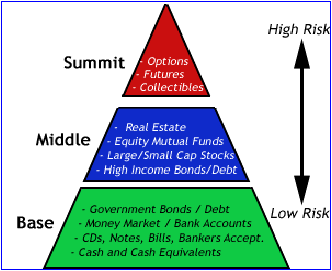Alternative Investments: Tap into
High Risk Gains with Swing Trading
Of the various investment vehicles available today, alternative investments offer the highest risk and potential for reward. Specialized training and trading strategies are required for each type. Some items trade in very illiquid markets, requiring long periods for a sales transaction to take place or special-purpose auctions where high net-worth individuals are present. For the highly liquid items, swing trading is an excellent method for mitigating risk and capturing short term gains.
Alternative investments are at the upper portion of the risk pyramid detailed below and include real estate, collectibles, foreign currencies, commodities, options, and futures.
Each investment modality is unique in its nature, risk profile and trading strategy:
- Real Estate: Real estate is a piece of land, including the air above it, the ground below it, and any buildings or structures on it. Real estate can relate to commercial or residential properties. Sales take time, are governed by local law, and are generally conducted with the aid of realtor/agent, although the individual who owns the property can facilitate the sale on his own.
- Collectibles: A collectible is any item that has value due to its rarity and desirability, including items like antiques, stamps, coins, and art. The item may also be manufactured specifically for the collecting market. The selling market is often illiquid, requiring an auction environment of specialized buyers to realize the highest possible sales price.
- Foreign Currencies (Forex): The world’s oldest and largest market, trading nearly $2.5 trillion in value every business day. Formally the province of only very large banks and financial institutions, creative brokers and technology have enabled access to a broad public audience. Popularity has grown enormously in the past five years due to its flexibility, liquidity and ease of access. Special training and practice sessions on free demo accounts are necessary for trading success. Forex broker reviews are available to help choose a trusted business partner.
- Commodities: A commodity is a physical substance, which is interchangeable with another product of the same type, like food, grains, and metals, and which investors buy or sell, usually through futures contracts. Prices of the commodity can fluctuate due to supply and demand forces in the marketplace. Products generally trade on a commodity exchange and can include foreign currencies and other financial instruments.
- Options: An option is the right, but not the obligation, to buy (a call) or sell (a put) a specific amount of a given stock, commodity, currency, index, or debt, at a strike price during a specified period of time. Each option has a buyer, called the holder, and a seller, known as the writer. If the option contract is exercised, the writer is responsible for fulfilling the terms of the contract. When an option is not exercised, it expires. No shares change hands and the money spent to purchase the option is lost.
- Futures: This last item is a standardized, transferable, exchange-traded contract that requires delivery of a commodity, bond, currency, or stock index, at a specified price, on a specified future date. Unlike options, futures convey an obligation to buy.
For the last four items, foreign currencies, commodities, options, and futures, there exist very liquid markets that trade actively on exchanges or large global networks. Investors, trained in the art of profiting from trading these securities, typically use “swing trading” to achieve their investment goals and objectives.

Swing trading is a style of trading that seeks to realize gains in a stock, currency or commodity within one to four days. Swing traders attempt to discern trends and patterns in pricing behavior, and then enter and exit the market with trades designed to capitalize on predictable market volatility. Technical analysis is used to provide market insights, and momentum indicators assist in establishing appropriate entry and exit points. The trader is not interested in the intrinsic value of the item traded, but is focused on profiting from both up and down price movements. Consistency is the goal, since no predictive algorithm is infallible. Since trade sizes tend to be small and liquid, the swing trader can move in and out of positions quickly, and does not have to compete with large institutions moving large lot sizes.
The risk profile for alternative investments is on the high end of the chart, and specialized training, typically from an industry professional, along with weeks of practice, is paramount to achieving success. The risk and active trading style may not fit your personality type. However, many investors have been drawn to these actively managed forms of investing and become skillful at the art of swing trading. After you have obtained a firm foundation in all other aspects of general investing, you may wish to investigate these topics to determine if they appeal to your “inner trader” instinct.
